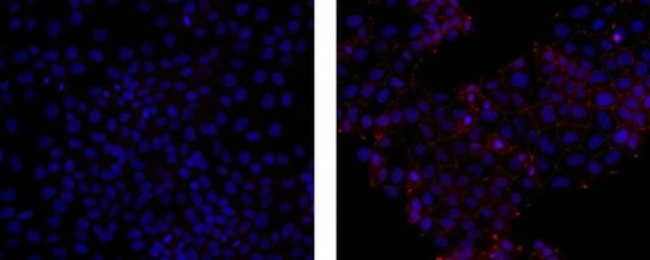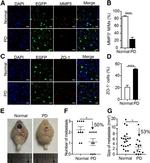Search Thermo Fisher Scientific
Invitrogen
ZO-1 Monoclonal Antibody (R26.4C), eFluor™ 570, eBioscience™
This Antibody was verified by Cell treatment to ensure that the antibody binds to the antigen stated.
Product Details
41-9776-82
Species Reactivity
Published species
Host/Isotype
Recommended Isotype Control
Class
Type
Clone
Conjugate
Excitation/Emission Max
Form
Concentration
Purification
Storage buffer
Contains
Storage conditions
Shipping conditions
RRID
Product Specific Information
Description: The monoclonal antibody R26.4C recognizes the tight junction protein 1, ZO-1 (zona occludens) of rat, mouse, canine, and porcine. ZO-1 is a member of the MAGUK family of tight junction associated scaffolding proteins, each containing a PDZ, SH3 and guanylate kinase-like (GUK) domain. ZO-1 is an integral member of the tight junction complex which forms a barrier to paracellular movement of substances, separating apical and basolateral fluids in relation to the epithelial cell layer. ZO-1 forms complexes with family members ZO-2, ZO-3, as well as occludin, cingulin, claudin-1-8, actin, alpha-catenin, the Ras-effector molecule AF-6, ZONAB, Apg-2, and the junctional adhesion molecules (JAM)-A-C. ZO-1 is thought to anchor the actin cytoskeleton to the tight junction. ZO-1 and ZO-2 have been shown to regulate cell cycle and proliferation with recent evidence highlighting the down-regulation of ZO-1 and ZO-2 with cancer progression.
Applications Reported: This R26.4C antibody has been reported for use in immunohistochemical staining of frozen tissue sections, microscopy, and immunocytochemistry.
Applications Tested: This R26.4C antibody has been tested by immunocytochemistry of formaldehyde-fixed and permeablized cells and can be used at less than or equal to 1 µg/mL. It is recommended that the antibody be carefully titrated for optimal performance in the assay of interest.
Filter Recommendation: When using this eFluor® 570 antibody conjugate, we recommend a filter that will capture the 570 emission wavelength (for example, Excitation 545/25, 565LP, Emission 605/70). A standard Alexa Fluor® 555 or TRITC filter is acceptable.
Excitation: 555 nm; Emission: 570 nm
Target Information
ZO-1 forms complexes with either ZO-2 or ZO-3. In addition, these proteins can also associate with claudin, occludin and F-actin, at tight junction stands, where they provide a linkage between the actin cytoskeleton and the tight junction. ZO-1 expression is significantly reduced in many breast cancer lines. ZO-2 and ZO-3 are ubiquitously expressed within epithelial tight junctions, and unlike ZO-1, which is also expressed at cell junctions of cardiac myocytes, ZO-2 is not expressed in nonepithelial tissue. ZO-1 is a protein located on a cytoplasmic membrane surface of intercellular tight junctions. ZO-1 may be involved in signal transduction at cell-cell junctions. Two transcript variants encoding distinct isoforms have been identified for the ZO-1 gene. Diseases associated with ZO-1 dysfunction include Celiac Disease and Congenital Nephrotic Syndrome.
For Research Use Only. Not for use in diagnostic procedures. Not for resale without express authorization.
Bioinformatics
Protein Aliases: DKFZp686M05161; MGC133289; OTTHUMP00000174520; Tight junction protein 1; tight junction protein 1 (zona occludens 1); Tight junction protein ZO-1; zona occludens 1; Zona occludens protein 1; Zonula occludens protein 1
Gene Aliases: TJP1; ZO-1; ZO1
UniProt ID: (Dog) O97758, (Mouse) P39447
Entrez Gene ID: (Dog) 403752, (Mouse) 21872, (Rat) 292994

Performance Guarantee
If an Invitrogen™ antibody doesn't perform as described on our website or datasheet,we'll replace the product at no cost to you, or provide you with a credit for a future purchase.*
Learn more
We're here to help
Get expert recommendations for common problems or connect directly with an on staff expert for technical assistance related to applications, equipment and general product use.
Contact tech support



